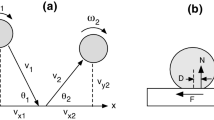Abstract
Measurements are presented on the oblique impact of a hollow rubber ball incident on a polished granite surface, and the results are compared with those for a solid rubber superball. The hollow ball had a much higher coefficient of sliding friction than the superball, resulting in significant differences in all bounce parameters, at all angles of incidence. The hollow ball gripped the surface at all observed angles of incidence, resulting in one or two reversals in the direction of the friction force during the impact. The friction force was measured directly, as was the rotation speed of the ball during the impact. The results show that the tangential coefficient of restitution of a ball depends on both the coefficient of sliding friction and the ratio of the tangential to the normal vibration frequency of the ball.










Similar content being viewed by others
References
Foerster S, Louge M, Chang H, Allia K (1994) Phys Fluids 6:1108–1115
Kharaz A, Gorham D, Salman A (2001) An experimental study of the elastic rebound of spheres. Powder Technol 120:281–291
Cross R (2002) Grip-slip behavior of a bouncing ball. Am J Phys 70(11):1093–1102
Smith L, Duris J (2009) Progress and challenges in numerically modeling solid sports balls with applications to softballs. J Sports Sci 27(4):353–360
Ranga D, Strangwood M (2010) Finite element modelling of the quasi-static and dynamic behaviour of a solid sports ball based on component material properties. Procedia Eng 2:3287– 3292
Rezaei A, Verhelst R, Van Paepegem W, Degriecka J (2011) Finite element modelling and experimental study of oblique soccer ball bounce. J Sports Sc 29(11):1201–1213
Carre MJ, James DM, Haake SJ (2004) Impact of a non-homogeneous sphere on a rigid surface. Proc Instn Mech Eng Part C: J Mech Eng Sci 218(3):273–281
Goodwill SR, Haake SJ (2004) Modelling of tennis ball impacts on a rigid surface, In: Proceedings Instn Mech Eng Part C: J Mech Eng Sci, Vol 218, pp 1139–1153
Goodwill SR, Kirk R, Haake SJ (2005) Experimental and finite element analysis of a tennis ball impact on a rigid surface. Sports Eng 8:145–158
Haake SJ, Carre MJ, Kirk R, Goodwill SR (2005) Oblique impact of thick walled pressurized spheres as used in tennis. Proc Instn Mech Eng Part C: J Mech Eng Sci 219(11):1179–1189
Tanaka K, Sato F, Oodaira H, Teranishi Y, Sato F, Ujihashi S (2006) Construction of the Finite-Element Models of Golf Balls and Simulations of Their Collisions, In: Proceedings IMechE Vol. 220 Part L: J. Materials: Design and Applications, 220, pp 13– 22
Tanaka K, Matsuoka K, Fujita S, Teranishi Y, Ujihashi S (2012) Construction of a finite element model for collisions of a golf ball with a club during swing. Proc. Instit. Mech. Eng., Part P: Jnl of Sports Eng and Tech 226 (2):96–106
Maw N, Barber JR, Fawcett JN (1981) The role of elastic tangential compliance in oblique impact. Jnl Lubr Technol 103:74–80
Labous L, Rosato A, Dave R (1997) Measurements of collisional properties of spheres using high-speed video analysis. Phys Rev E 56(5):5717–5725
Lorenz A, Tuozzolo C, Louge M (1997) Measurement of impact properties of small, nearly spherical particles. Exp Mech 37(3):292–298
Cross R (2002) Measurements of the horizontal coefficient of restitution for a superball and a tennis ball. Am J Phys 70(5):482–489
Garland P, Rogers R (2009) An experimental study of contact forces during oblique elastic impact. J App Mech 76:031–015
Cross R (2003) Measurements of the horizontal and vertical speeds of tennis courts. Sports Eng 6:93–109
Maw N, Barber JR, Fawcett JN (1976) The oblique impact of elastic spheres. Wear 38(1):101–114
Garwin R (1969) Kinematics of an ultraelastic rough ball. Am J Phys 37(1):88–92
Cross R (1999) Impact behavior of hollow balls. Am J Phys 82(3):189–195
Cross R (2008) Differences between bouncing balls, springs, and rods. Am J Phys 76(10):908–915
Kuninaka H, Hayakawa H (2004) Anomalous behavior of the coefficient of normal restitution in oblique impact. Phys Rev Letts 93(15):154301-1-4
Louge M, Adams M (2002) Anomalous behavior of normal kinematic restitution in the oblique impacts of a hard sphere on an elastoplastic plate. Phys Rev E 65:021303-1-6
Author information
Authors and Affiliations
Corresponding author
Rights and permissions
About this article
Cite this article
Cross, R. Oblique Bounce of a Rubber Ball. Exp Mech 54, 1523–1536 (2014). https://doi.org/10.1007/s11340-014-9938-3
Received:
Accepted:
Published:
Issue Date:
DOI: https://doi.org/10.1007/s11340-014-9938-3




